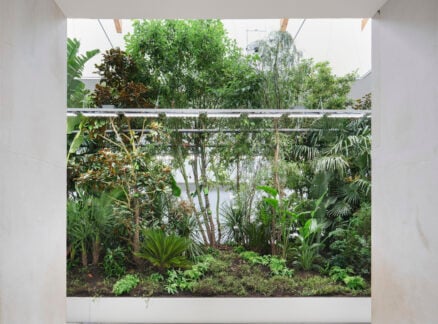October 27, 2014
On China’s Problem with "Weird" Architecture
How seriously should architects take Xi Jinping’s remarks on unusual buildings?
Last week, the Chinese head of state voiced his distaste for Beijing’s unusual contemporary architecture. OMA’s design for the CCTV headquarters was directly implicated in the president’s remarks.
Courtesy Jim Gourley via flickr
Chinese president Xi Jinping’s remarks about “no more weird architecture” have been all over the web in recent days and it seems everyone building in China has taken note.
Xi’s brief comments on the state of contemporary architecture in China were part of a two-hour speech at a literary symposium in Beijing. According the state-run Xinhua News Agency (which has since deleted the comments), and as translated by the Wall Street Journal, Xi was referring specifically to CCTV headquarters, designed by OMA. Using the building, known locally as “Big Pants,” as an example, the president voiced his criticisms of architecture he considers qiqiguaiguai, roughly translated as “strange” or “weird,” and suggested that such buildings are “unlikely” to be built again in Beijing.
“It’s clear he is calling for substance over ‘ivory towers,’” says Alex Yong, vice president and China general manager for Venice, California-based, Jerde Partnership. “This makes sense given that China is seeing the limits of its growth,” he adds.
It also makes sense in the current political climate of clamping down on corruption associated with China’s development-fueled boom and recent moves to shift the economy toward a cooled-down, consumer-based model, one less driven by the engine of real estate. Xi might be singling out CCTV as an example of the type of pricey overindulgence he doesn’t want to see perpetuated on his watch.
It’s also important to keep in mind that these comments about architecture were made in the context of exhorting artists of all kinds to communicate “Chinese values” through their work. As quoted in the New York Times, Xi’s speech stressed the importance of building up a cultural identity that reflects China’s geopolitical centrality. “Chinese art will further develop only when we make foreign things serve China, and bring Chinese and Western arts together via thorough understanding,” Xi said. He added that the arts should “disseminate contemporary Chinese values, embody traditional Chinese culture, and reflect Chinese people’s aesthetic pursuit.”
As architects, “qiqiguaiguai” is in our blood cells.
This is a common theme that runs through China’s on-going attempts to define its contemporary culture and to temper the state’s hot-cold relationship with artists, like Ai Weiwei, who frequently push aesthetic and political boundaries a little too far. There is a tension in Chinese politics between the desire to encourage innovation and originality while also having art that “should be like sunshine from blue sky and breeze in spring that will inspire minds, warm hearts, cultivate taste, and clean up undesirable work styles,” as Xi stated.
“It’s easy to put labels on things that are unfamiliar and architecture, being so obvious, just happens to be the scapegoat of the moment,” says architect Qingyun Ma, founder of the firm MADA s.p.a.m. and dean of the University of Southern California School of Architecture. “Everyone is in a moment of panic about things that are unfamiliar or novel, but as architects, qiqiguaiguai is in our blood cells, and I think we should push it to the front lines. This is the basis for a progressive China.”
This doesn’t mean, however, that architects should disregard context. “It’s hard to argue with Xi’s basic premise that there has been a lot of naughty behavior over the last decade—enormous projects built extremely quickly with little consideration of either internal function or external neighborhood,” says Mike Tunkey, a principal of CannonDesign who has worked in China since the late nineties. “Xi’s comments can be read as China’s postmodern or New Urbanist critique. It also happens to be very much in line with his larger vision of moving towards sustainable development.”
According to Tunkey, the real question now is how this will be used in the design procurement process. He wonders if local design institutes will use Xi’s comments against foreign firms who are—fairly or unfairly—seen as the primary offenders of “weirdness.”
Will there be a substantive backlash against qiqiguaiguai? Tunkey thinks not. “Without reforms to building and zoning there is unlikely to be anything but superficial change. Projects might look different, but they will still be big and fast.”
Recent Viewpoints
Viewpoints
Sustainability News Updates for Q2 2025





